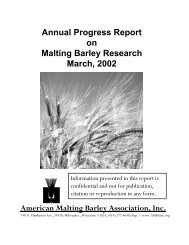Annual Progress Report on Malting Barley Research March, 2007
Annual Progress Report on Malting Barley Research March, 2007
Annual Progress Report on Malting Barley Research March, 2007
Create successful ePaper yourself
Turn your PDF publications into a flip-book with our unique Google optimized e-Paper software.
Beta-limit dextrin<br />
Alpha-Amylase<br />
Alpha- 1, 6 branch<br />
Small dextrin + sugars<br />
Figure 3. Endo-activity of alpha-amylase <strong>on</strong> beta-limit dextrin substrate. Products are<br />
small dextrins and sugars. As the size of the substrate decreases, the ability to bind<br />
iodine is lost.<br />
However, the situati<strong>on</strong> is not as simple as presented in figure 3. Starch (amylopectin) is<br />
described as being composed of A, B and C-Chains. The C-chain is the central chain<br />
carrying the reducing group, while the outermost A-chains are unbranched. While the Bchains<br />
are branched, they may have very l<strong>on</strong>g unbranched segments. Figure 4 shows a<br />
representative diagram of a porti<strong>on</strong> of the starch molecule (the complete molecule may<br />
c<strong>on</strong>tain > 1 x 10 6 glucose residues). The shaded circles show glucose residues that<br />
would be initially removed by beta-amylase (as maltose) in the preparati<strong>on</strong> of beta-limit<br />
dextrin. However, when the beta-limit dextrin is used in the assay of alpha-amylase, its<br />
acti<strong>on</strong> opens up these unbranched B-chain residues, and they then become susceptible<br />
to beta-amylase. The glucose residues that would become susceptible to beta-, <strong>on</strong>ly<br />
after attack by alpha-amylase are shown with striped circles. The length of these<br />
susceptible unbranched B-regi<strong>on</strong>s can be c<strong>on</strong>siderable (>50 glucose) and they are<br />
associated with iodine binding. As such, it seems possible that the use of beta-limit<br />
dextrin in the assay of malt alpha-amylase may not completely eliminate interference<br />
from beta-amylase.<br />
79
















